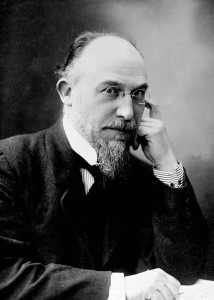 In 1917 as Erik Satie was working on his masterpiece Socrate, he penned a little treatise to which he appended the title “Subject matter (idea) and craftsmanship (construction).†The whole is quoted in books on Satie by Robert Orledge and others, but I don’t find it on the internet outside of scholarly writings, and I think it deserves to be better known:
In 1917 as Erik Satie was working on his masterpiece Socrate, he penned a little treatise to which he appended the title “Subject matter (idea) and craftsmanship (construction).†The whole is quoted in books on Satie by Robert Orledge and others, but I don’t find it on the internet outside of scholarly writings, and I think it deserves to be better known:
* * * * * * * * * * * * * * *
Craftsmanship is often superior to subject matter.
To have a feeling for harmony is to have a feeling for tonality.
The serious examination of a melody will always, for the pupil, be the essence of an excellent harmonic exercise.
A melody does not imply its harmony, any more than a landscape implies its color. The harmonic character of a melody is infinite for a melody is an expression within the overall Expression.
Do not forget that the melody is the Idea, the outline; at the same time as being the form and the subject matter of a work. The harmony is an illumination, an explanation of the subject, its reflection.
In composition, the various parts, between themselves, no longer have connections with any ‘school’. The ‘school’ of composition has a gymnastic aim, nothing more; composition has an aesthetic aim, in which taste alone plays a part.
Make no mistake: the understanding of grammar does not imply the understanding of literature; grammar can help or be held in reserve as the writer pleases and on his responsibility. Musical grammar is nothing but grammar.
One cannot criticize the craft of an artist as if it constituted a system. If there is form and a new style of writing, there is a new craft.
To speak of ‘craft’ requires great care and – at all events – great learning.
Who possesses such learning?
The error arises in that a great many artists lack ideas in general and even specific ideas.
The Masters of the past were brilliant through their ideas, their craft was a simple means to an end, nothing more. It is their ideas which endure. . . .
Become artists unconsciously.
The Idea can do without Art.
Let us mistrust Art: it is often nothing but virtuosity.
Impressionism is the art of Imprecision; today we tend towards Precision.
* * * * * * * * * * * * * * * *
According to Orledge (“Satie’s Approach to Composition in His Later Years (1913-24), Proceedings of the Royal Musical Association, Vol. 111. (1984-1985), p. 157), the original French is published as item 37 in Erik Satie: Écrits (réunis, établis et annotés par Ornella Volta), (Paris, 1977), pp. 48-9, and there is some question as to whether the final, more politically immediate sentence belongs with the rest of the text. I was drawn back to it by finding in Satie’s Art vs. Idea an echo of Ives’s Manner vs. Substance.
